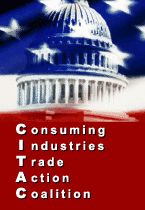
 |

|
Executive Summary As part of the Section 201 Investigation on steel imports initiated by the Bush Administration, each of the six U.S. International Trade Commission (ITC) Commissioners recommended on December 7, 2001 that the President impose a range of tariffs and quotas on steel imports into the United States. The covered imports amount to approximately 74 percent of total volume of steel imports. Steel-consuming industries have predicted that the recommended tariffs and quotas would force many of them out of business and others to lay off manufacturing and other workers in an economy that can ill-afford more job losses. They predict recommended remedies would result in more harm than benefit to the economy. At the request of The Consuming Industries Trade Action Coalition (CITAC), Trade Partnership Worldwide, LLC analyzed the potential impact of the ITC recommendations on steel-producing, steel-consuming and other sectors of the U.S. economy. The study estimated the effects of two scenarios: imposition of weighted average tariff recommendations for all products of 9.2 percent on imports other than Canada and Mexico of the products on which the ITC found injury (low tariff scenario), and imposition of average tariffs, weighted by the value of imports, of 20.7 percent on those imports (high tariff scenario). The results are as follows:
About the Model Trade Partnership Worldwide, LLC employed a state-of-the-art computable general equilibrium (CGE) model to estimate the potential impacts of the proposed remedies on the U.S. economy generally, and the steel industry and steel-consuming industries specifically. CGE models are the tools of choice for assessment of the economic impact of regional and multilateral trade agreements. They allow for the assessment of the effects on broad sectors of the economy of protecting one sector, including interactions between sectors that may result. The model we used, based on the Global Trade Analysis Project (GTAP), reflects the interactions across the entire U.S. economy, rather than just within the protected industry (i.e. steel) and its immediate customers. 1 The linkages between sectors are both direct (like the input of steel in the production of automobiles) and indirect (like the use of mining inputs into steel, which feed indirectly into automobiles, and the use of both energy services and steel in the production of automobiles). The model contains 15 specific sectors: food; other primary goods; mining; steel; non-ferrous metals; fabricated metals; chemicals, rubber and plastics; refineries; automobiles and parts; other transport equipment; electrical equipment; non-electrical equipment; other manufactures; construction; and services. Trade Partnership Worldwide benchmarked the model's data for national income, trade flows and related data to the year 2000.2 In modeling the impact of the proposed remedies, we take into account the current economic climate. Hence, the model includes job creation and destruction (i.e. unemployment) as potential gaps are created between labor earnings and the value of labor output across sectors 3. Throughout, we assume that Canada and Mexico are left off of the remedy list. Total effects across states are based on detailed BLS data on state level employment, combined with estimated effects at the national level. 1.The model therefore is able to capture the details of up- and down-stream impacts of trade protection, as well as the total costs to consumers and benefits to U.S. producers. It captures important linkages between sectors, in terms of both intermediate demands and competition in labor and capital markets. "Partial equilibrium" analysis can only capture the total costs to consumers and the benefits to the protected industries. The model used for this study defines the United States as a "large country," in other words, one with market power in import and export markets. 2.Basic national income data came from the Global Trade Analysis Project (GTAP) data set, updated to the most recent full year, and supplemented with data from the U.S. Department of Commerce, the Bureau of Labor Statistics, the International Monetary Fund, and the American Iron and Steel Institute. 3.For example, this means we explicitly model the release of worker from the fabricated metals industry as input costs are driven up. |
|||||||||||||||||||